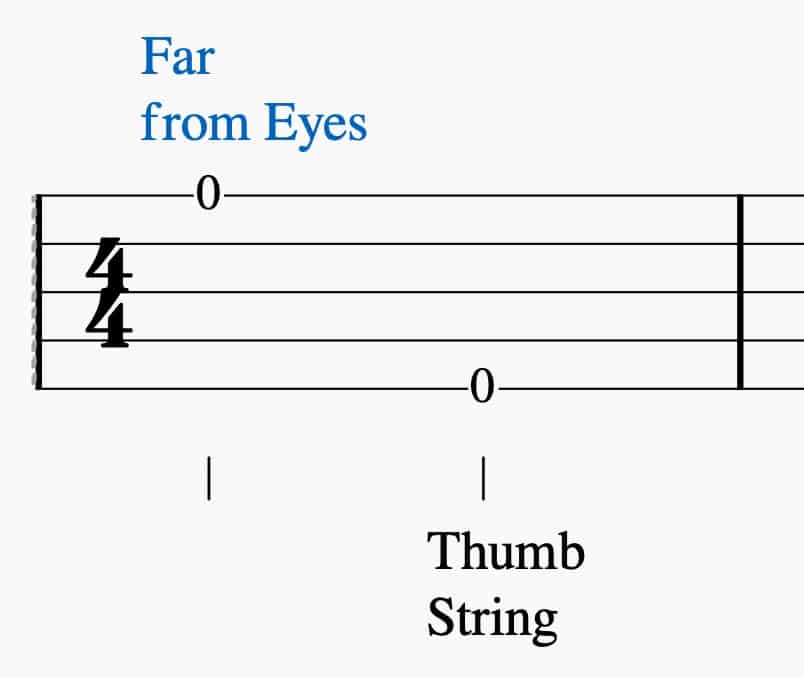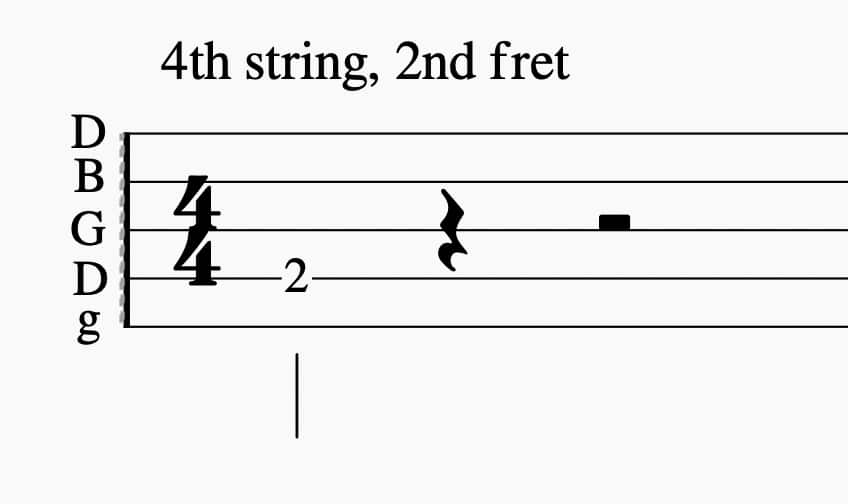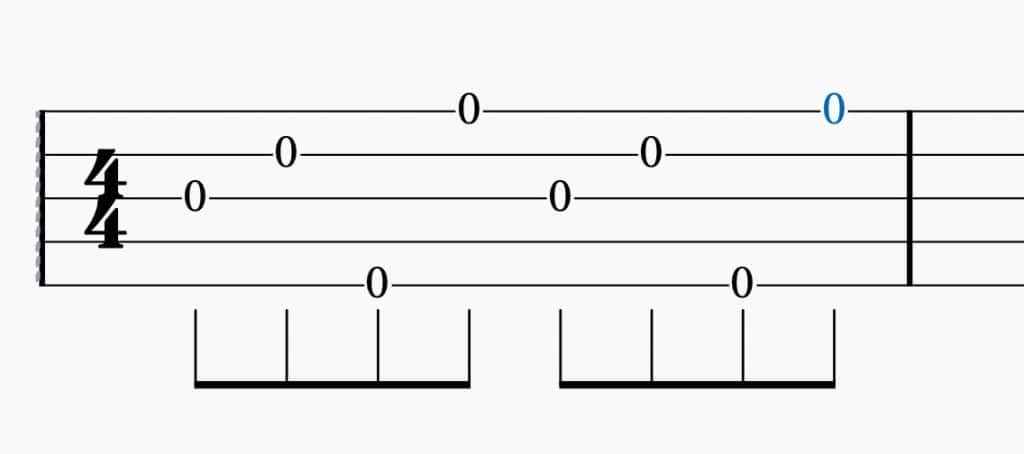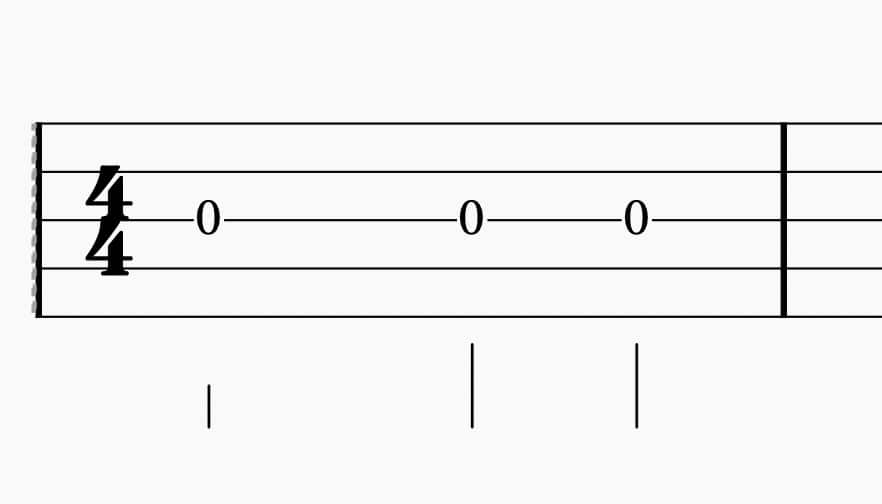Tablature, or TAB for short, has been around since the early lute music days. It goes all the way back to the 1300’s. It rose to popularity in banjo music after the publication of the Earl Scruggs banjo book and others. Today, I’ll cover how to read and think about banjo tablature. Afterwards, I’ll get into the advantages and disadvantages of the banjo tab. I’ll also show you some tricks I use to read tablature faster (so you eventually aren’t reading it one note at a time!)
Reading Banjo TAB
Here is our first piece of TAB. For now, don’t pay any attention to any of the symbols except the lines and the number zero. I’ll come back to these later. The main purpose is to teach you how to translate the notes in the TAB to your banjo.
Take note of the letters next to the string. This will help you relate them back to how your banjo is tuned. I use a lowercase g to designate the 5th or thumb string. Some people find thinking in terms of these letters or note names at first helps.

The zero on the page represents an OPEN string (no fretting). The numbers or frets are simple enough to understand.
Usually, where the problem begins for most with TAB is that the lines seem backwards. As you can see, this top line is labeled the first string, open.
If you ever forget which one is your first string, the best way to remember it-The FIRST STRING is the one furthest from your eyes while holding the banjo in your lap.
Here is a way to visualize the relationship between these tablature lines and how you see the banjo in your lap:
Take the plane of the lines and imagine rotating it 90 degrees away from you, now the first string is the one furthest away. Now, keep rotating it another 45 degrees downward. This is basically how it looks to you while holding the banjo.
Let’s try adding another note to further clarify the orientation of the strings:

Here, I have added the 5th or thumb string open to the TAB. Notice that it is positioned at the bottom of the TAB. This can be quite confusing to those that are used to standard notation, as the highest pitch string is the LOWEST on the TAB. Once again, imagine the plane of the strings rotated away 90 degrees and this will help you see it.
Now, go back to the first note, hit it a few times, looking at the TAB and then hit the second note. Make sure you visually get the relationship between where these notes lie within the TAB versus your banjo.
One last single note example:

Here, we have the 4th string, 2nd fret. The 2 is telling you the FRET or where on the fretboard to put your fingers. Count backwards from the top line (1-2-3-4). We are on the fourth string. So, the 2nd fret, 4th string is the note we want.
What does a banjo roll look like in TAB?
Most bluegrass banjo is done with rolls. Therefore, let’s take a look at a roll in banjo TAB.

Boy, the pace has seriously picked up here. Look at all of those notes. What is going on?
This is an alternating-thumb roll (3 2 5 1 pattern). Forget those connecting lines down at the bottom for a moment, I’ll come back to all of that. Just look at the lines and what strings you’d hit. My advice- Learn the roll (if you don’t already know it) and then practice doing it while reading this TAB. 3 2 5 1 3 2 51 (all open strings. The blue note is just my mouse highlighter, nothing of value there in a normal TAB.
A Banjo Chord in Banjo TAB
Sometimes you have to hit more than one note at once. Usually in the function of a banjo chord. Here is what a chord would look like in Banjo TAB

You have three notes stacked on top of one another. You know it is a chord because they are in the same location within the measure (not staggered). This means you play them at the same time. Any time you see notes on top of one another like this, it means to play them all at the same time (via a plucking motion of the strings with your right-hand).
Next, let’s go back to some questions you probably have about all those weird lines at the bottom of the TAB.
Reading Banjo TAB rhythms

The first section there has four notes (all open 3rd strings) with straight lines pointed down. These are called QUARTER NOTES. The first symbol in the measure is a 4 over the top of another 4. This symbol is called the time signature. It’s telling you that there are four beats per measure and that one quarter note gets one beat. If this is confusing, don’t stress over it too much now. The reality is most banjo music is in this time signature and it is as easy as counting to four.
The first measure is counted 1 2 3 4, just like counting your basic number set out loud. Each of those notes has to be of the same duration and length. So none is played faster than the other. All EVENLY SPACED.
In the second section, you’ll see the notes have lines pointed down but they are all attached with another horizontal line. These are called eighth notes. You’ll notice it takes eight of these to complete one measure, whereas, the previous quarter notes, it only took four to complete one measure. Eighth notes are faster than quarter notes. Twice as fast!
Eight notes are typically counted like this:
1 AND 2 AND 3 AND 4 AND
The great news is most banjo music is not rhythmically complicated. These are the two primary note values you will see. However, there are notes of longer durations occasionally.
This first note in this following TAB is called the half note.

You are probably wondering, how do I know this is a half note when it looks EXACTLY like a quarter note? First off, notice the distance between the notes. The distance between the first and second note is greater than the distance between the 2nd and 3rd notes. The 2nd and 3rd notes are quarter notes just like you saw previously.
To figure this out, a bit of math is involved. Remember, each measure has to have four beats.
The 2nd and 3rd notes each last one beat. So, you already have two beats being ‘consumed’ by these two. 4-2 = 2. Therefore, the only way this works is if that first note equals TWO beats.
What you are partly seeing here is one of the downfalls of TAB versus standard notation. TAB is not very good at conveying rhythm values once things get more complicated. Eventually, if you see these types of patterns enough, you’ll just remember them. However, it can be a bit aggravating in the beginning to figure out.
In normal sheet music, you’d get a circle surrounding the note, clearly denoting it as a half note. You don’t get that with TAB. What you get is a quarter note and a half note looking identical and they leave it to you to do the math. At the same time, usually, you do get some sort of hint via spacing.
Here is a complete mixture of note values in banjo tab:

In some ways, I recommend working backwards to figure this out. The last two notes are eighth notes. The note before that is a quarter note. So far, we have two beats out of four taken up. This means the first note must be a half note again.
This is how you’d count and play this measure
(1….2)…..3……4 AND
Concluding words about reading Banjo TAB
If any of the rhythmic notation is confusing, don’t fret. I believe that as you learn songs and work through them, you’ll start to get the hang of how these lines translate into words and sounds.
Please consider signing up for my BANJO JOURNEY NEWSLETTER. I’ll notify you when I update the blog or post new products. I also send out FREE banjo tips.
If you’d like to speed up your ability to read BANJO ROLLS in Tablature, check out this video:
I’ve just released a Beginner Banjo Roll Checklist with TABS. This is a great way to ease into reading TABS.